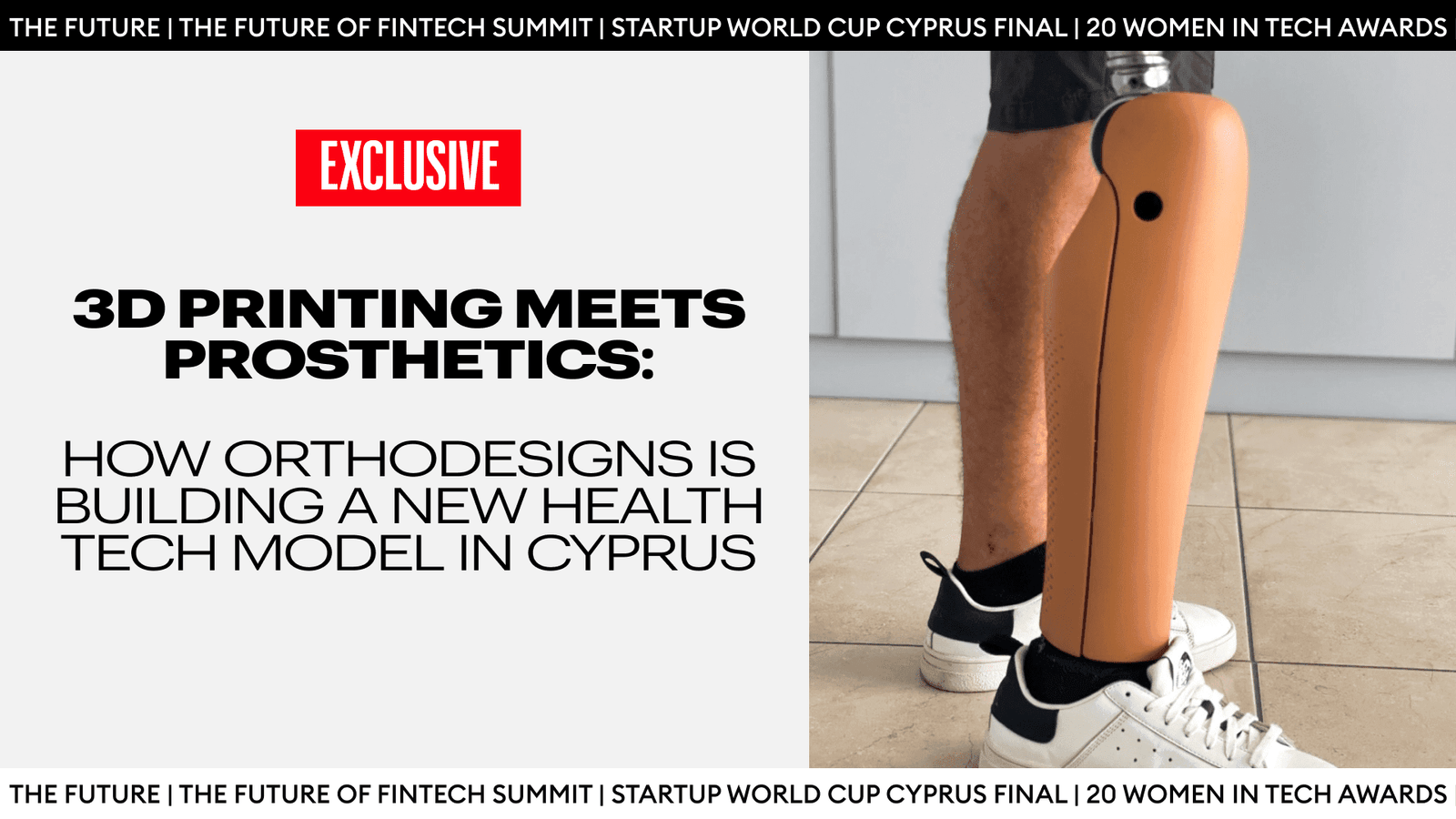Cyprus spends more than USD 436.6 million annually on imported medicines, according to CEIC Data. The European Commission reports the country’s dependence on “high-tech imports”, indicating a healthcare system with limited domestic production and slower adoption of advanced technologies than in larger EU markets.
One company is showing another way forward. OrthoDesigns, based in Limassol, is the first in Cyprus to apply 3D printing to prosthetics and orthotics, reducing production times, improving precision, and giving patients a more consistent experience than traditional methods.
Follow THE FUTURE on LinkedIn, Facebook, Instagram, X and Telegram
The venture is co-led by Kyriakos Efstathiou, a clinical prosthetist and orthotist trained at the University of Strathclyde in Glasgow, and his business partner Savvas Savva, a technician with long experience in the field. Together, they introduced digital manufacturing of prosthetics and orthotics to Cyprus, so patients can now receive advanced devices without depending on imports or treatment abroad. The company is beginning to expand this approach through partnerships in Greece, Norway, Saudi Arabia, and Dubai, transferring its methods and technology to other labs.
In this interview with The Future Media, Efstathiou discusses his path into prosthetics, the obstacles of bringing new technology to Cyprus, and his vision for where 3D printing can take patient care.
Market Context
The market for 3D-printed prosthetics and orthotics is growing quickly, but it is still new compared to traditional methods. According to Towards Healthcare, the global prosthetics segment is worth about USD 1.79 billion in 2024 and could more than double by 2034. In Europe, revenue was USD 369 million in 2023 and is forecast to reach USD 609 million by 2030, as reported by Grand View Research. Orthotics is larger again, valued close to USD 5 billion today, with steady growth ahead.
Despite this momentum, most devices are still made with plaster molds and manual fabrication, which can take weeks. 3D printing offers faster turnaround and more accurate fits, while also reducing material waste and allowing production to take place closer to the point of care. Companies such as 3D Systems, Formlabs, and Materialise are advancing these solutions. Only a handful of markets have widely adopted 3D printing in prosthetics, while most continue with manual production.
Cyprus continues to rely on imported devices, which makes the introduction of advanced production methods an important development.
Could you start by telling us a bit about your background and how you first got involved in orthopedic design?
My background is as a clinical prosthetist and orthotist. Back in 2017, I came across this profession almost by accident. I studied at the University of Strathclyde in Glasgow for four years and worked briefly in the UK before returning to Cyprus. During my studies, I experimented with 3D printing prosthetic covers and saw a gap in the market. Not many professionals trusted the technology at that time, but I believed it had huge potential.
For people who aren’t familiar with your work, what does OrthoDesigns offer?
OrthoDesigns is a 3D-printing company specializing in prosthetics and orthotics. We work directly with clinics and healthcare providers, offering wholesale manufacturing services. Essentially, the clinics handle the patient examinations and prescriptions, and we take care of the production process to deliver the final custom device. We collaborate with different clinics across Cyprus, so patients go through their assessments locally, and then we manufacture the device that meets their specific needs.
What led you to start OrthoDesigns? Was there a specific problem you saw in Cyprus that made you feel something needed to change?
The need was always there. People required prosthetics, diabetic insoles, and spinal braces, but the process was slow and inconsistent. Everything was manual and labor-intensive. A patient might wait one or two weeks for a socket, and the results could vary depending on the technician’s skill. With 3D printing, you just scan the limb, design digitally, and have a device ready within a day. That kind of accuracy and speed didn’t exist before.
In Cyprus, we have GESY, the national health system, and it helps patients access some prosthetics and orthotics. However, the coverage is limited to only some products within the field. So while there is support, it doesn’t always match the actual needs.
I wanted to come back to Cyprus to help the community and believed something strong could be built here. In 2021, I sat down with my co-founder and discussed the idea for 3D printing. I was working in the UK at the time, so I knew it was either start the work now or never. That’s when we decided to move forward with OrthoDesigns.
What gave you the confidence to bring 3D printing into such a traditional field and into Cyprus?
Globally, 3D printing was not fully trusted in our profession, so bringing it into Cyprus was a big challenge. But during my studies, I saw how powerful it could be in terms of speed and precision. When I came back, we kept experimenting, testing different materials and methods. If something didn’t meet our standards, we rejected it and tried again. Over time, we reached a point where we had reliable products that clinicians could accept.
How did you fund and test your early products?
We started very small. We started in 2021 with a basic 3D printer. We modified it and used it to test different materials. Most, if not all, of the early prototypes didn’t work. If they failed, we just threw them away and started over from scratch. It was all trial and error. Over time, we found what was reliable enough to use clinically. Funding was mostly personal in the beginning. We didn’t have big investors or grants, so it was step by step, proving that each device could actually help a patient.
What was it like working with your first clients?
At the start, it was very difficult because people didn’t trust the technology. We had to convince clinicians to try it, and that took time. But once the first patients started using the devices, the feedback was positive. They felt the comfort, they saw the difference. From there, it became easier because the results spoke for themselves. By focusing on the ‘Product is king’ mentality, we were able to constantly improve the product rapidly and pivot based on our partner’s feedback.
How do you manage such detailed customization in a market with limited resources?
That’s one of the advantages of 3D printing. In the past, making a spinal brace or a socket was entirely manual and could take hours of labor. Now you scan the patient, design digitally, and the printer produces it. The computer does the heavy work. It saves us time and materials. Even though Cyprus is a small market, the technology allows us to offer the same quality you would expect in bigger countries. The resources are limited, but the process is efficient, and the results are consistent.
What kinds of materials do you use, and how are they sourced?
We use medical-grade materials that are certified for prosthetics and orthotics. It’s not just about printing with any plastic. Everything needs to be biocompatible and safe for the patient. Most of the materials are imported from specialized suppliers in Europe. We test them carefully before using them, because if a material fails, it can affect someone’s health. We also experiment with new filaments as they come to the market, but only if they meet our standards. That way, we can make sure the devices are both safe and reliable.
How do you ensure quality and safety standards are met?
Every device goes through testing before it reaches a patient. We follow European standards for medical devices, and we only use certified materials. The final product is inspected by our team of certified clinicians and technicians. If something doesn’t meet the standards, it doesn’t go out. It’s as simple as that. Patients rely on these devices every day, so safety has to come first.
How do you collaborate with clinics in Cyprus and abroad?
In Cyprus, we work with clinics in all the major cities. The patients go there for their clinical examination, and then we take over the manufacturing. That way, we don’t compete with the clinics; we support them. Abroad, it works similarly. We have partners in Greece, Norway, Saudi Arabia, and Dubai. We share our methods and technology with them so they can integrate 3D printing into their own services. Step by step, we are building a network of clinics that use the same process.
What challenges have you faced in trying to scale internationally?
Every country has different regulations, and that can slow things down. What works in Cyprus might not be accepted the same way in another country. You also need to build trust with clinicians and patients, because people are used to traditional methods. Convincing them to adopt something new takes time. Logistics is another challenge. Since Cyprus is an island, shipping abroad can increase costs and delivery times compared to shipping within Cyprus. Still, by planning carefully and working closely with our partners, we manage to deliver reliably despite these challenges.
What’s next for OrthoDesigns?
We want to keep expanding our network abroad and bring more clinics into the process. That way, patients everywhere can benefit from faster and more accurate devices. We’re also testing new materials as they come to the market, always with safety as the priority. A key step in this journey is our InnoSoles project, which allows clinics to produce custom 3D-printed insoles in-house using our specialized software, printers, and materials. It’s a practical example of how digital manufacturing can improve efficiency and patient care. OrthoDesigns’s vision is simple: to make 3D-printed prosthetic and orthotic products accessible to clinics worldwide, so that 3D printing becomes a normal part of the profession, not something seen as experimental.















